Effect of Low Temperature on the Undrained Shear Strength of Deep-Sea Clay by Mini-Ball Penetration Tests
Abstract
:1. Introduction
2. Methodology
2.1. Sediment Samples
2.2. Physical Properties of Sediment Samples
3. Results
3.1. Temperature Calibration of the Load Cell
3.2. Penetration Tests at Room and Low Temperatures
4. Results and Analysis
4.1. Penetration Results at Room and Low Temperatures
4.2. Strength Difference at Room and Low Temperatures
5. Discussion
5.1. Effect of Temperature on the Clay Sturcture
5.1.1. Effect of Temperature on Clay Particles
5.1.2. Effect of Temperature on Bound Water
5.2. Effect of Temperature on Free Water
5.3. Summary of the Temperature Effect Mechanism
6. Conclusions
- (1)
- The undrained shear strength of the sediment segments tested by the mini-ball method showed a 14.1–30.0% increase with decreasing temperature from 20 °C to 4 °C, which was consistent with the research of Gue et al. and Lunne et al.;
- (2)
- In the clay structure, both the clay particles and the bound water were affected by temperature. As the temperature decreased from 20 °C to 4 °C, based on SEM tests, the clay particles were less affected by temperature. However, the increases in electrostatic forces, hydrogen bonds between the clay particles and water molecules, and van der Waals forces between the water molecules led to an increase in the strength of the bound water, which was manifested as an increase in the undrained shear strength of the clay;
- (3)
- The free water in sediment segments was also affected by temperature. As the temperature decreased from 20 °C to 4 °C, the viscosity of the free water increased by 54.5%, which increased the undrained shear strength of the sediment segments.
Author Contributions
Funding
Institutional Review Board Statement
Informed Consent Statement
Data Availability Statement
Acknowledgments
Conflicts of Interest
References
- Guo, X.; Nian, T.; Wang, D.; Gu, Z. Evaluation of undrained shear strength of surficial marine clays using ball penetration-based CFD modelling. Acta Geotech. 2022, 17, 1627–1643. [Google Scholar] [CrossRef]
- Fan, N.; Jiang, J.; Dong, Y.; Guo, L.; Song, L. Approach for evaluating instantaneous impact forces during submarine slide-pipeline interaction considering the inertial action. Ocean Eng. 2022, 245, 110466. [Google Scholar] [CrossRef]
- Nian, T.; Guo, X.; Fan, N.; Jiao, H.; Li, D. Impact forces of submarine landslides on suspended pipelines considering the low-temperature environment. Appl. Ocean Res. 2018, 81, 116–125. [Google Scholar] [CrossRef]
- Amon, D.; Gobin, J.; Van Dover, C.; Levin, L.; Marsh, L.; Raineault, N. Characterization of methane-seep communities in a deep-sea area designated for oil and natural gas exploitation off Trinidad and Tobago. Front. Mar. Sci. 2017, 4, 342. [Google Scholar] [CrossRef] [Green Version]
- Guo, X.; Stoesser, T.; Nian, T.; Jia, Y.; Liu, X. Effect of pipeline surface roughness on peak impact forces caused by submarine mudflow. Ocean Eng. 2022, 243, 110184. [Google Scholar] [CrossRef]
- Al-Umar, M.; Fall, M.; Daneshfar, B. GIS-based modelling of snowmelt-induced landslide susceptibility of sensitive marine clays. Geoenviron. Disasters 2020, 7, 9. [Google Scholar] [CrossRef] [Green Version]
- Nian, T.; Shen, Y.; Zheng, D.; Lei, D. Research advances on the chain disasters of submarine landslides. J. Eng. Geol. 2021, 29, 1657–1675. [Google Scholar]
- Nian, T.; Song, X.; Zhao, W.; Jiao, H.; Guo, X. Submarine slope failure due to overpressure fluid associated with gas hydrate dissociation. Environ. Geotech. 2020, 9, 108–123. [Google Scholar] [CrossRef]
- Fu, C.; Nian, T.; Guo, X.; Gu, Z.; Zheng, D. Investigation on responses and capacity of offshore pipelines subjected to submarine landslides. Appl. Ocean Res. 2021, 117, 102904. [Google Scholar] [CrossRef]
- Guo, X.; Nian, T.; Zhao, W.; Gu, Z.; Liu, C.; Liu, X.; Jia, Y. Centrifuge experiment on the penetration test for evaluating undrained strength of deep-sea surface soils. Int. J. Min. Sci. Technol. 2022, 32, 363–373. [Google Scholar] [CrossRef]
- Coffin, S.; Weisberg, S.; Rochman, C.; Kooi, M.; Koelmans, A. Risk Characterization of Microplastics in San Francisco Bay, California. Microplast. Nanoplast. 2022, 2, 9. [Google Scholar] [CrossRef]
- Lunne, T. The CPT in offshore soil investigations-a historic perspective. In Proceedings of the 2nd International Symposium on Cone Penetration Testing, Hundtington Beach, CA, USA, 9–11 May 2010. [Google Scholar]
- Jin, C.; Wang, J. A preliminary study of the gas hydrate stability zone in the South China Sea. Acta Geol. Sin.-Engl. Ed. 2002, 76, 423–428. [Google Scholar] [CrossRef]
- Mitchell, J. Shearing resistance of soils as a rate process. J. Soil Mech. Found. Div. 1964, 90, 29–61. [Google Scholar] [CrossRef]
- Perkins, S.; Sjursen, M. Effect of cold temperatures on properties of unfrozen Troll clay. Can. Geotech. J. 2009, 46, 1473–1481. [Google Scholar] [CrossRef]
- Gue, C.; Lunne, T.; Perkins, S. Temperature effects on laboratory measured strength on deep water soft clays. In Frontiers in Offshore Geotechnics III, Proceedings of the 3rd International Symposium on Frontiers in Offshore Geotechnics (ISFOG 2015); Taylor & Francis Books Ltd.: Abingdon, UK, 2015; Volume 1, pp. 1055–1060. [Google Scholar]
- Kelleher, P.; Randolph, M. Seabed geotechnical characterization with a ball penetrometer deployed from the portable remotely operated drill. In Proceedings of the International Symposium on Frontiers in Offshore Geotechnics (ISFOG), Perth, WA, Australia, 19–21 August 2005; pp. 365–371. [Google Scholar]
- Yafrate, N.; DeJong, J.; DeGroot, D.; Randolph, M. Evaluation of remoulded shear strength and sensitivity of soft clay using full-flow penetrometers. J. Geotech. Geoenviron. Eng. 2009, 135, 1179–1189. [Google Scholar] [CrossRef]
- Low, H.; Randolph, M.; Lunne, T.; Andersen, K.; Sjursen, M. Effect of soil characteristics on relative values of piezocone, T-bar and ball penetration resistances. Géotechnique 2011, 61, 651–664. [Google Scholar] [CrossRef]
- Lunne, T.; Andersen, K.; Low, H.; Randolph, M.; Sjursen, M. Guidelines for offshore in situ testing and interpretation in deepwater soft clays. Can. Geotech. J. 2011, 48, 543–556. [Google Scholar] [CrossRef]
- DeJong, J.; Yafrate, N.; DeGroot, D.; Low, H.; Randolph, M. Recommended practice for full-flow penetrometer testing and analysis. Geotech. Test. J. 2010, 33, 137–149. [Google Scholar] [CrossRef]
- DeJong, J.; Yafrate, N.; DeGroot, D. Evaluation of undrained shear strength using full-flow penetrometers. J. Geotech. Geoenviron. Eng. 2011, 137, 14–26. [Google Scholar] [CrossRef]
- Long, M.; Colreavy, C.; Ward, D.; Quigley, P. Piezoball tests in soft Irish clays. In Proceedings of the 3rd International Symposium on Cone Penetration Testing, Las Vegas, NV, USA, 13–14 May 2014; Volume 14. [Google Scholar]
- Stewart, D. A new site investigation tool for the centrifuge. In Proceedings of the International Conference Centrifuge 91, Boulder, Colorado, 13–14 January 1991. [Google Scholar]
- Stewart, D.; Randolph, M. T-bar penetration testing in soft clay. J. Geotech. Eng.-ASCE 1994, 120, 2230–2235. [Google Scholar] [CrossRef]
- Randolph, M.; Hefer, P.; Geise, J.; Watson, P. Improved seabed strenght profiling using T-bar penetrometer. In Offshore Site Investigation and Foundation Behaviour: New Frontiers, Proceedings of the International Conference, London, UK, 22–24 September 1998; Society of Underwater Technology: London, UK, 1998. [Google Scholar]
- GB/T 50145-2007; Standard for Engineering Classification of Soil. China National Standards: Beijing China, 2007.
- ASTM D2487-00; Standard Practice for Classification of Soils for Engineering Purposes (Unified Soil Classification System). American Society for Testing and Materials (ASTM): West Conshohocken, PA, USA, 2000.
- Lehane, B.; O’loughlin, C.; Gaudin, C.; Randolph, M. Rate effects on penetrometer resistance in kaolin. Géotechnique 2009, 59, 41–52. [Google Scholar] [CrossRef]
- Zhou, M.; Hossain, M.; Hu, Y.; Liu, H. Behaviour of ball penetrometer in uniform single-and double-layer clays. Géotechnique 2013, 63, 682–694. [Google Scholar] [CrossRef]
- Martin, C.; Randolph, M. Upper-bound analysis of lateral pile capacity in cohesive soil. Géotechnique 2006, 56, 141–145. [Google Scholar] [CrossRef]
- Nguyen, T.; Chung, S. Ball penetration test for characterization of soft clays. Proc. Inst. Civ. Eng.-Geotech. Eng. 2018, 171, 133–146. [Google Scholar] [CrossRef]
- Liu, J.; Chen, X.; Han, C.; Wang, X. Estimation of intact undrained shear strength of clay using full-flow penetrometers. Comput. Geotech. 2019, 115, 103161. [Google Scholar] [CrossRef]
- Lunne, T.; Gue, C.; Perkins, S.; Selvig, M. Temperature effects on laboratory strength measured on soft clays sampled in deepwater and cold environments. In Offshore Site Investigation and Geotechnics: Integrated Technologies-Present and Future; Society of Underwater Technology: London, UK, 2012. [Google Scholar]
- Nian, T.; Jiao, H.; Fan, N.; Guo, X. Microstructure analysis on the dynamic behavior of marine clay in the South China Sea. Mar. Geores. Geotechnol. 2020, 38, 349–362. [Google Scholar] [CrossRef]
- Kong, J.; Gao, X.; Xiao, J.; Wei, H.; Tian, H.; Sun, J.; Lv, C. Soil Mechanics and Foundations; China Electric Power Press: Beijing, China, 2015. [Google Scholar]
- Li, G. Advanced Soil Mechanics, 2nd ed.; Tsinghua University Press: Beijing, China, 2016. [Google Scholar]
- Liu, G.; Liu, H.; Gong, X.; Zhang, J. Geotechnics and Soil Mechanics; Science Press: Beijing, China, 2009. [Google Scholar]
- Muller, N.; Reiter, R. Temperature dependence of chemical shifts of protons in hydrogen bonds. J. Chem. Phys. 1965, 42, 3265–3269. [Google Scholar] [CrossRef]
- Raiteri, P.; Laio, A.; Parrinello, M. Correlations among hydrogen bonds in liquid water. Phys. Rev. Lett. 2004, 93, 087801. [Google Scholar] [CrossRef]
- Parsegian, V.; Ninham, B. Temperature-dependent van der Waals forces. Biophys. J. 1970, 10, 664–674. [Google Scholar] [CrossRef] [Green Version]
- Guo, X.; Nian, T.; Wang, Z.; Zhao, W.; Fan, N.; Jiao, H. Low-temperature rheological behaviour of submarine mudflows. J. Waterw. Port Coast. Ocean Eng. 2020, 146, 04019043. [Google Scholar] [CrossRef]
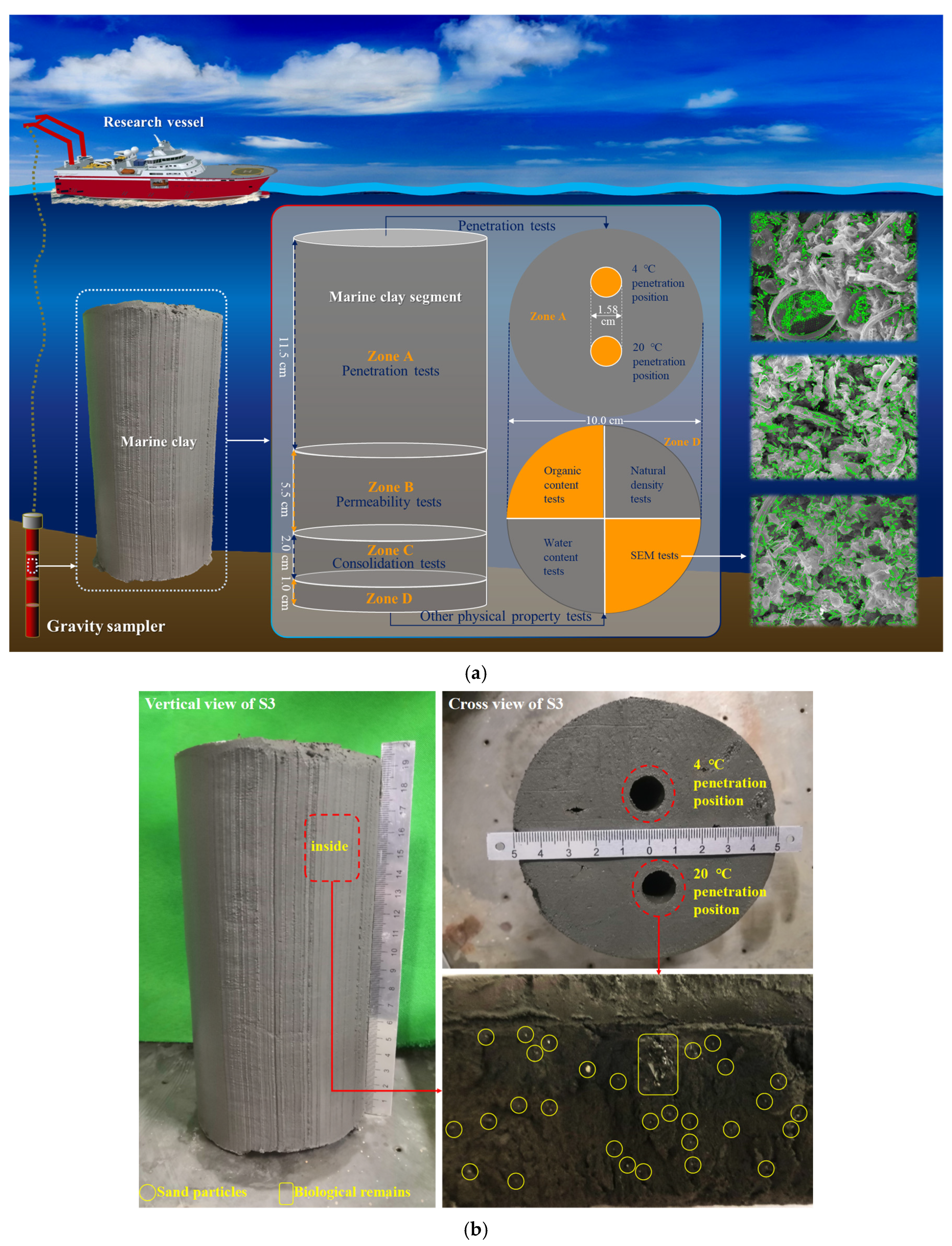
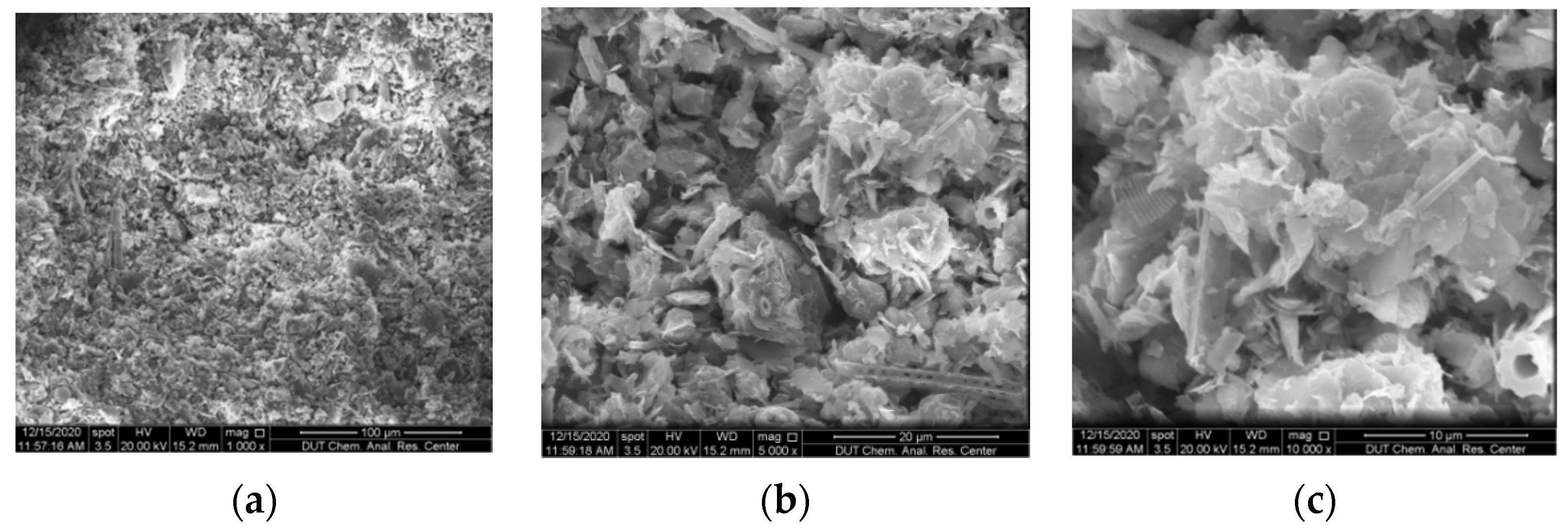
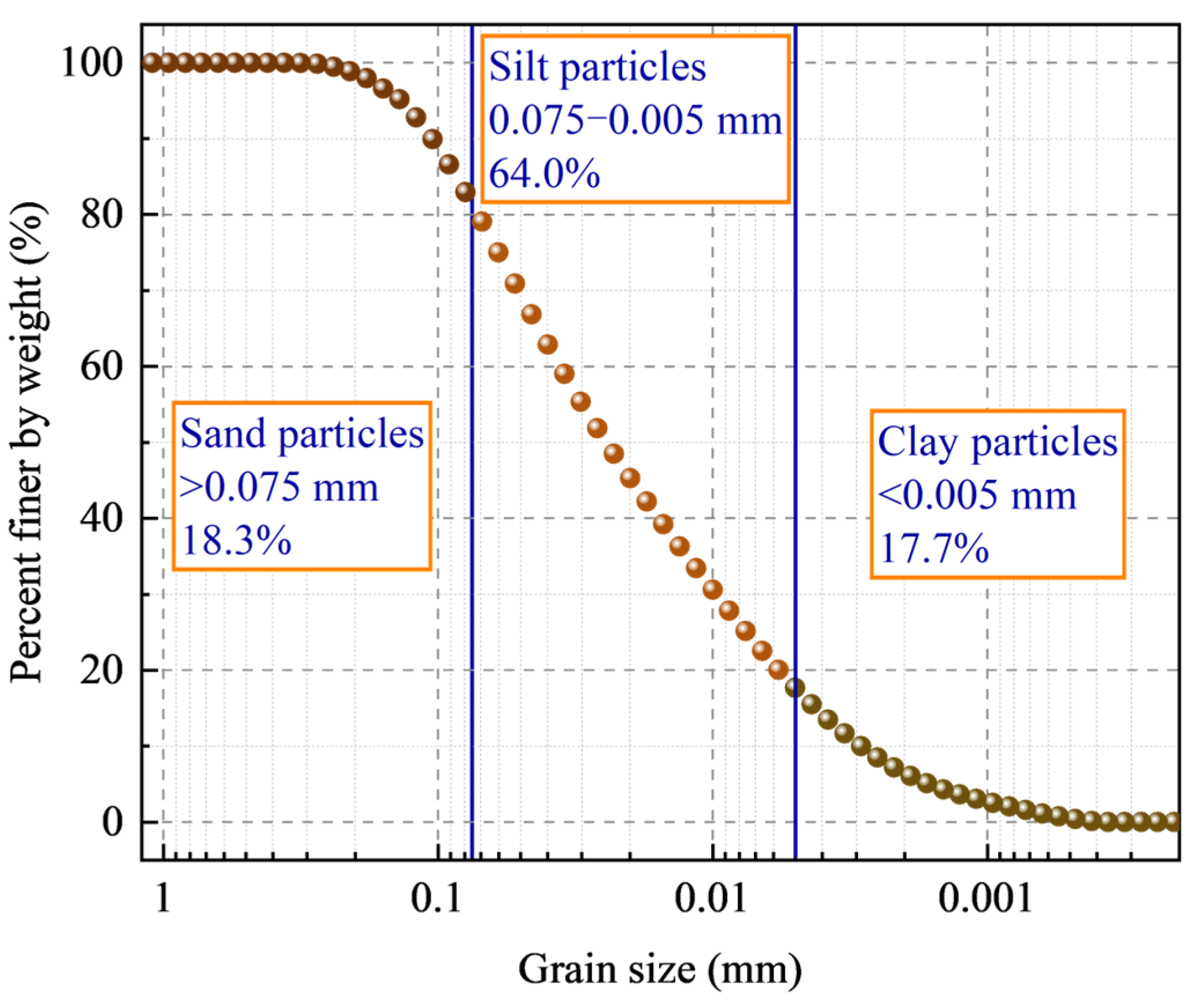
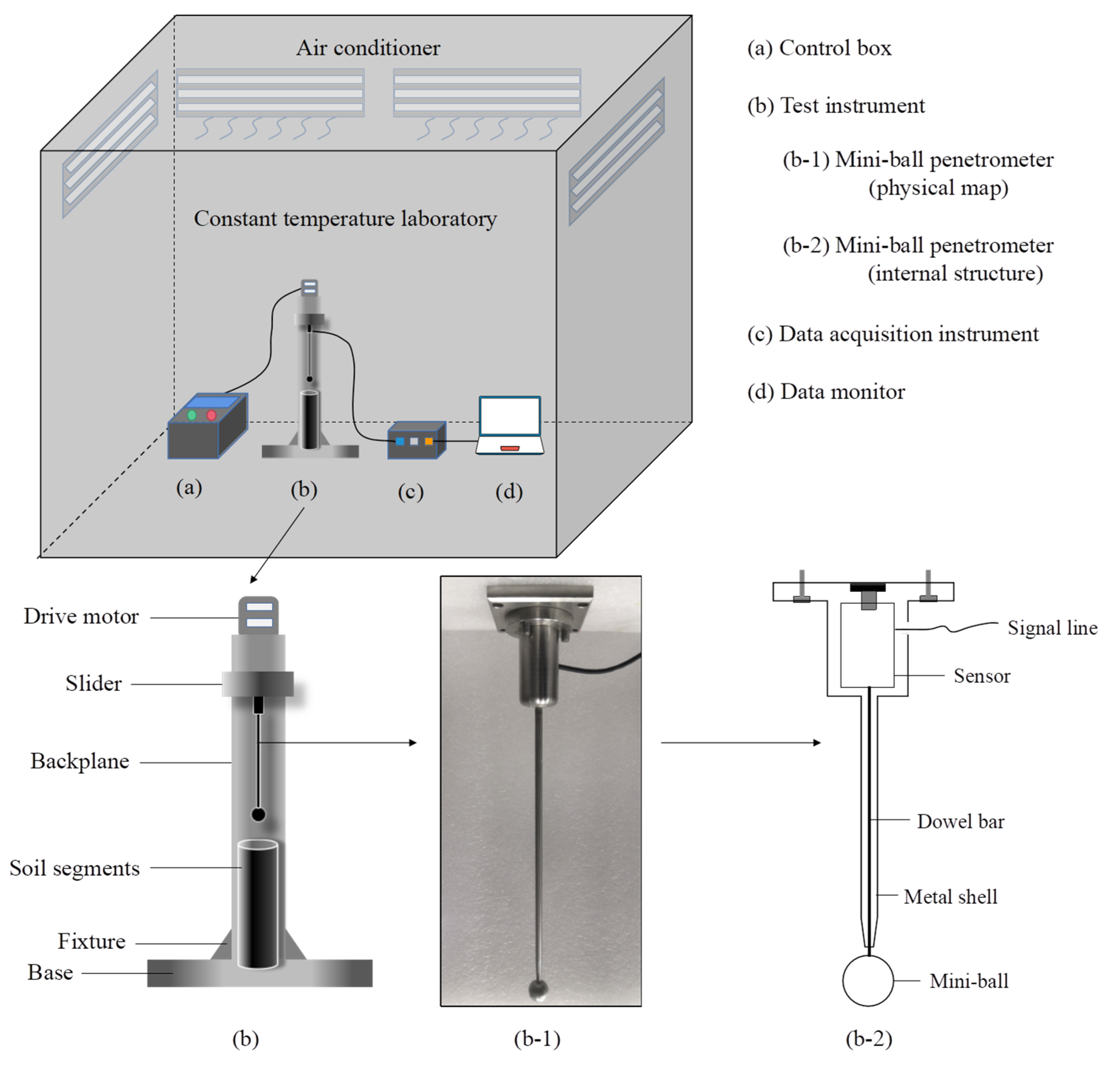
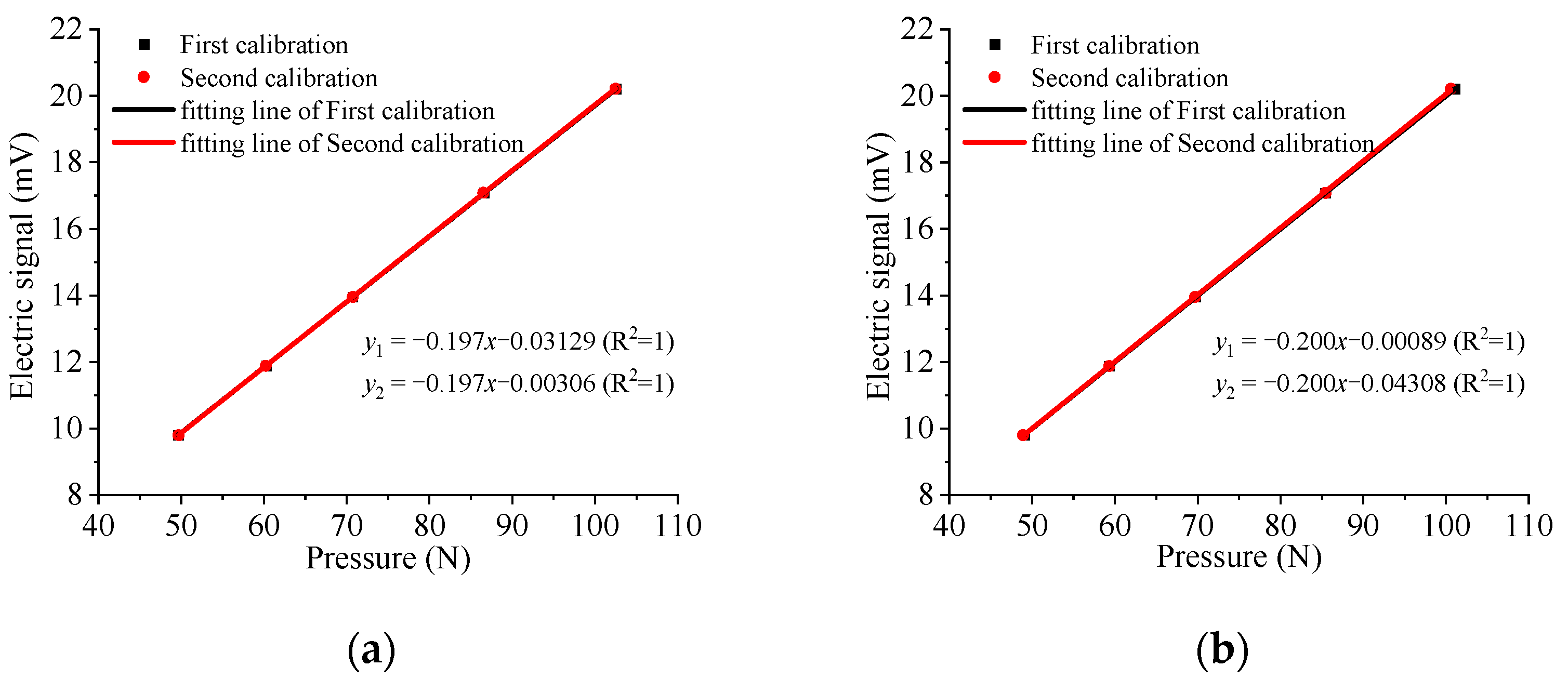
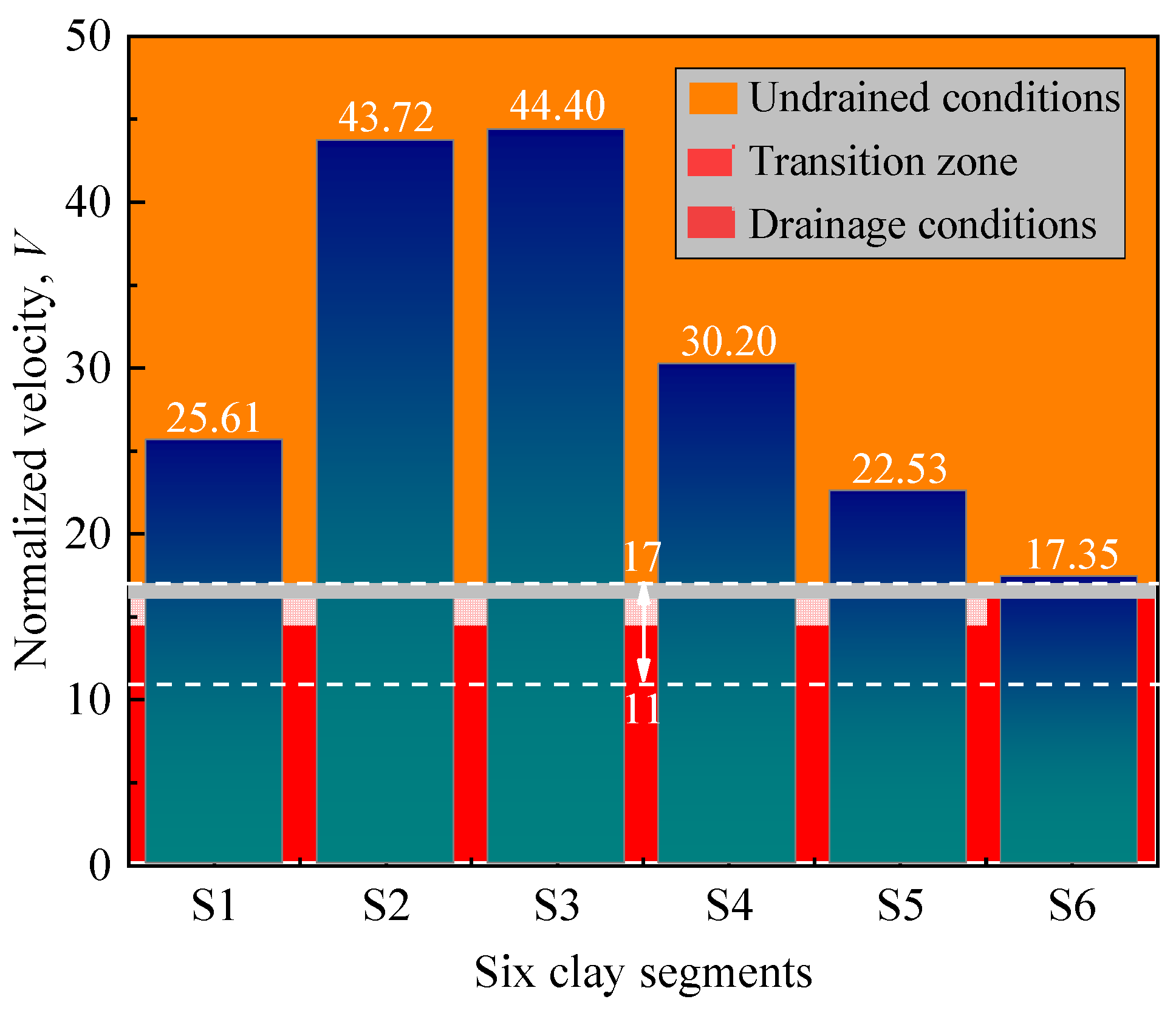


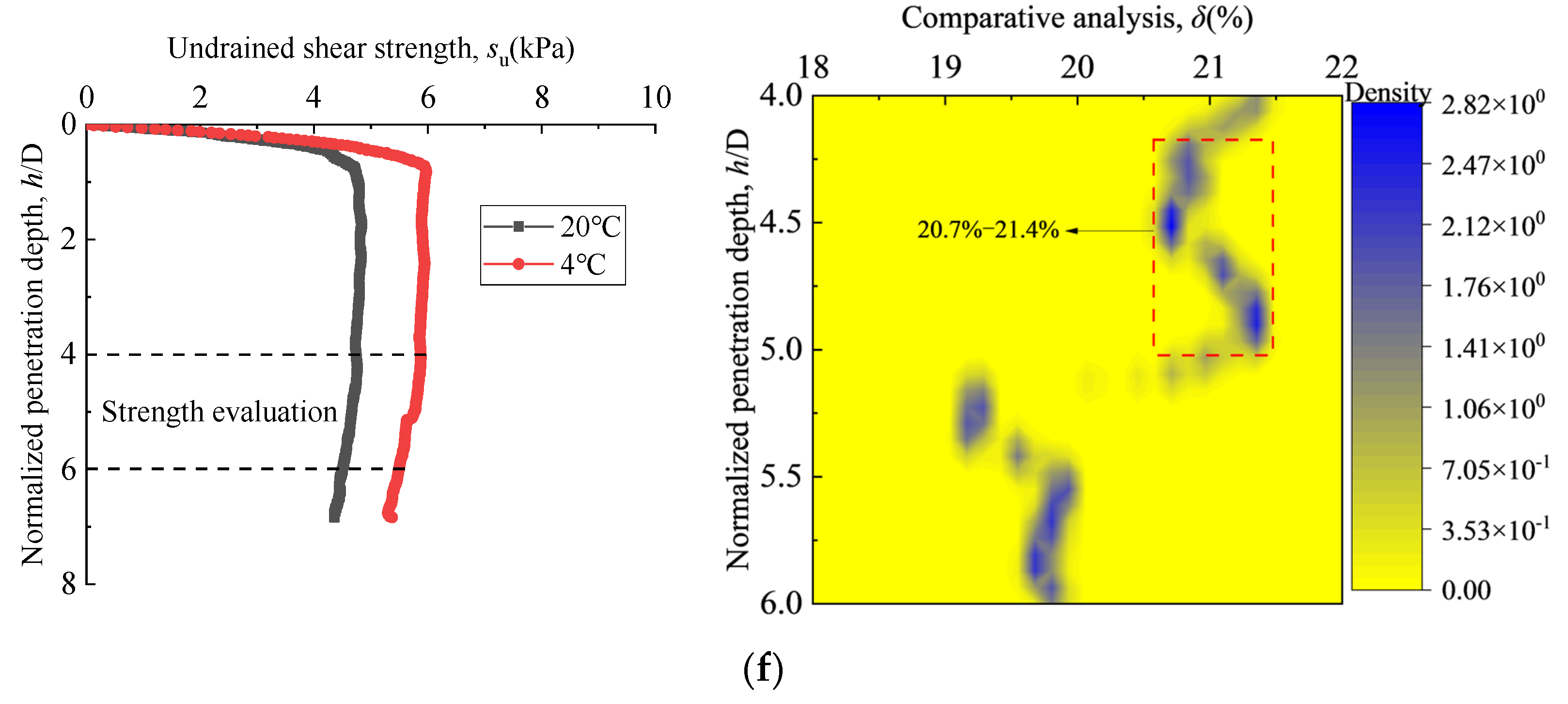
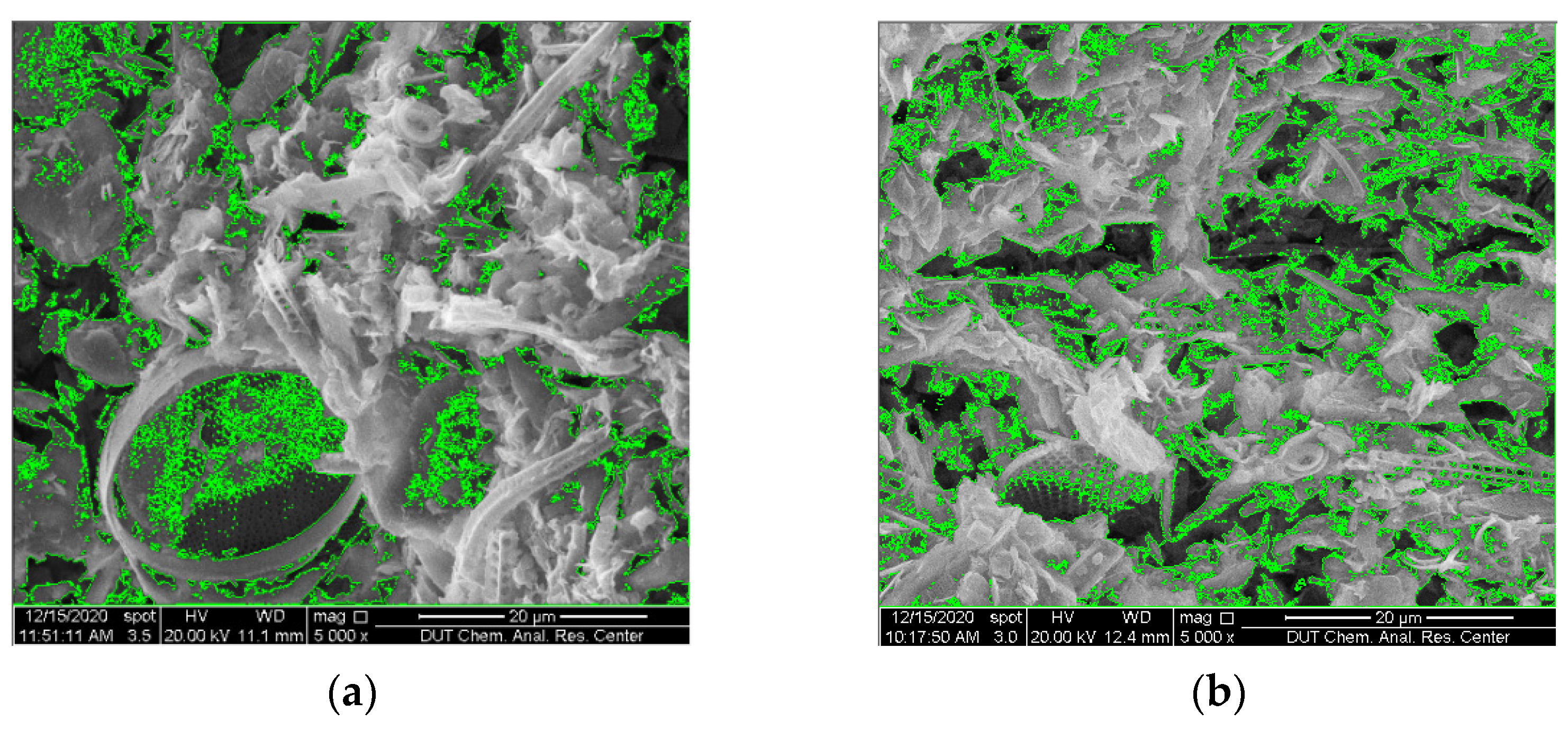


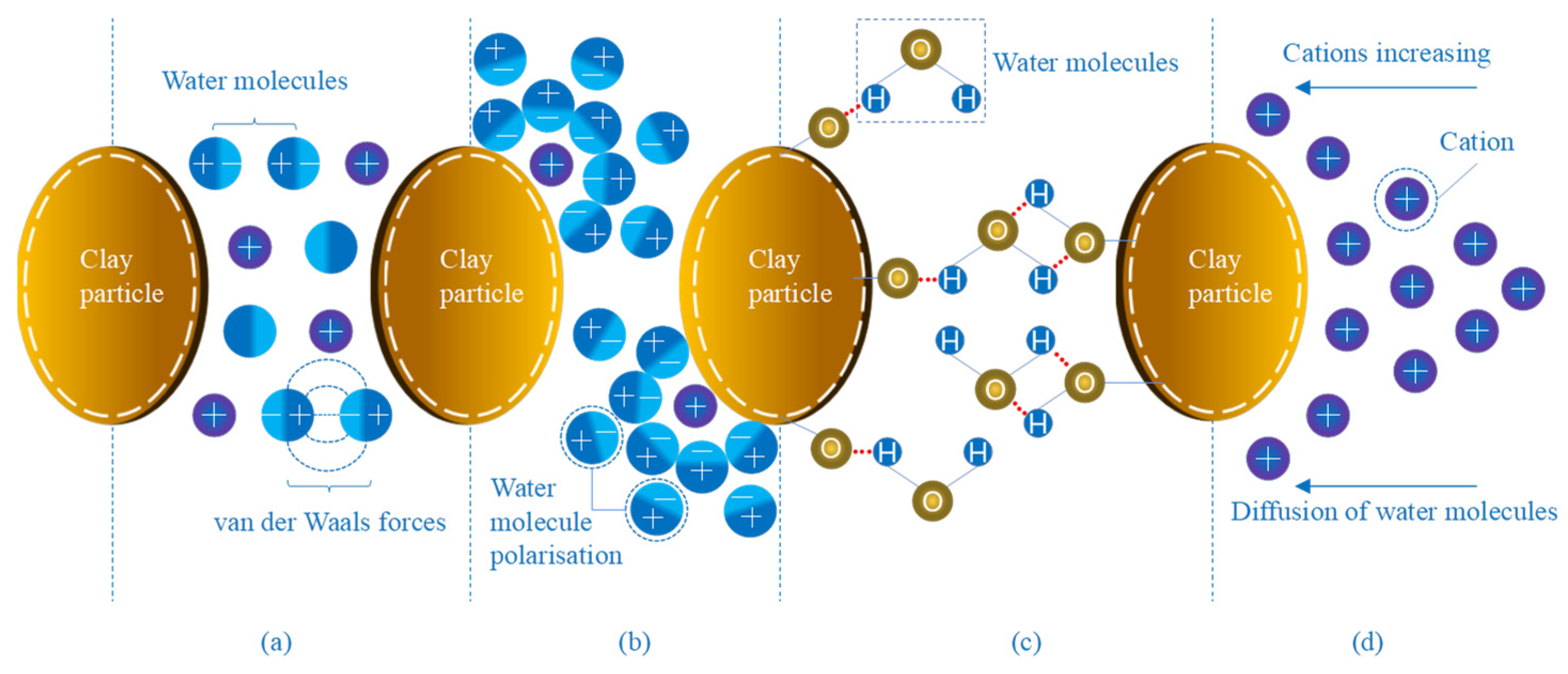
| Clay Segments | Depth | Water Content (w) | Density (ρ) | Plastic Limit (wP) | Liquid Limit (wL) | Plastic Index (IP) | Liquid Index (IL) | Compression Coefficient (a) | Permeability Coefficient (k) | Organic Content | Mean Grain Size (D50) | Specific Gravity (GS) |
|---|---|---|---|---|---|---|---|---|---|---|---|---|
| cm | % | g/cm3 | % | % | - | - | MPa−1 | 10−7 cm/s | % | μm | - | |
| S1 | 0–20 | 97.62 | 1.48 | 36.75 | 64.42 | 27.67 | 2.20 | 1.04 | 3.62 | 2.71 | 17.568 | 2.65 |
| S2 | 50–70 | 93.85 | 1.60 | 33.40 | 56.64 | 23.24 | 2.60 | 1.26 | 2.83 | 2.24 | 28.777 | |
| S3 | 100–120 | 87.01 | 1.52 | 35.29 | 60.82 | 25.53 | 2.03 | 1.58 | 3.29 | 2.17 | 48.663 | 2.78 |
| S4 | 150–170 | 90.73 | 1.50 | 35.72 | 58.91 | 23.19 | 2.37 | 1.20 | 3.54 | 2.04 | 23.456 | |
| S5 | 200–220 | 93.62 | 1.45 | 34.74 | 56.70 | 21.96 | 2.68 | 1.22 | 4.67 | 1.92 | 20.136 | 2.74 |
| S6 | 250–270 | 109.33 | 1.49 | 35.73 | 57.82 | 22.09 | 3.33 | 1.00 | 4.76 | 2.07 | 23.827 |
| Detail Information | NBall | Researchers |
|---|---|---|
| Soft massive clay and shelly massive clay. DIS-2 and DIS-5, located in the floodplain of the Nakdong River delta, west of Busan, Korea. | 12.09–12.21 | Nguyen and Chung [32] |
| Irish clay, located in Athlone, Belfast, Lough Erne | 12.00 | Long et al. [23] |
| Onshore sites: Onsøy (Norway), Burswood (Australia), Ariake (Japan) Offshore sites: West Africa, Norwegian Sea, Timor Sea, and offshore Egypt | 12.00–12.38 | Low et al. [19] |
| Kaolin clay, Laboratory tests (1 g) | 12.50 | Liu et al. [33] |
| Clay Segments | Depth (cm) | δ (%) | ||
|---|---|---|---|---|
| Max. | Min. | Ave. (δT) | ||
| S1 | 0–20 | 17.5 | 17.1 | 17.3 |
| S2 | 50–70 | 17.3 | 10.8 | 14.1 |
| S4 | 150–170 | 30.6 | 29.4 | 30.0 |
| S5 | 200–220 | 20.2 | 15.1 | 17.7 |
| S6 | 250–270 | 21.4 | 20.7 | 21.1 |
Publisher’s Note: MDPI stays neutral with regard to jurisdictional claims in published maps and institutional affiliations. |
© 2022 by the authors. Licensee MDPI, Basel, Switzerland. This article is an open access article distributed under the terms and conditions of the Creative Commons Attribution (CC BY) license (https://creativecommons.org/licenses/by/4.0/).
Share and Cite
Gu, Z.; Guo, X.; Jiao, H.; Jia, Y.; Nian, T. Effect of Low Temperature on the Undrained Shear Strength of Deep-Sea Clay by Mini-Ball Penetration Tests. J. Mar. Sci. Eng. 2022, 10, 1424. https://doi.org/10.3390/jmse10101424
Gu Z, Guo X, Jiao H, Jia Y, Nian T. Effect of Low Temperature on the Undrained Shear Strength of Deep-Sea Clay by Mini-Ball Penetration Tests. Journal of Marine Science and Engineering. 2022; 10(10):1424. https://doi.org/10.3390/jmse10101424
Chicago/Turabian StyleGu, Zhongde, Xingsen Guo, Houbin Jiao, Yonggang Jia, and Tingkai Nian. 2022. "Effect of Low Temperature on the Undrained Shear Strength of Deep-Sea Clay by Mini-Ball Penetration Tests" Journal of Marine Science and Engineering 10, no. 10: 1424. https://doi.org/10.3390/jmse10101424
APA StyleGu, Z., Guo, X., Jiao, H., Jia, Y., & Nian, T. (2022). Effect of Low Temperature on the Undrained Shear Strength of Deep-Sea Clay by Mini-Ball Penetration Tests. Journal of Marine Science and Engineering, 10(10), 1424. https://doi.org/10.3390/jmse10101424








